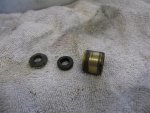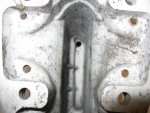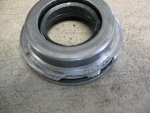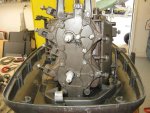gm280
Supreme Mariner
- Joined
- Jun 26, 2011
- Messages
- 14,605
This is a repost from my project: http://forums.iboats.com/boat-resto...n-outboard-who-knows-what-trailer-586483.html
I have never built an outboard, but after completely disassembling this Johnson 40 HP, it seems a little easier then all the 4 cycles I've rebuild thus far. I have already ordered most of the parts (seals, "o" rings, gaskets, bearings and such). I also have stripped, sand-blasted and cleaned all the individual parts in preparation for primer (either etching, Zinc Chromate, or Epoxy haven't decide on that yet either) base coat and top coats of clear. That does bring me to another question concerning the lower foot to this engine. I know there is a bushing and two "O" ring seals installed in the foot for the shifter rod to pass through per the IPB (Illistrated Parts Breakdown);

If you look at part numbers 18, 19, and 20 you will see what I'm questioning. In the actual engine factory manual they show and say to knock these parts out from the top through to the bottom as pictured. My question is these parts look to be installed from the top and therefore should be removed from the bottom up in my uneducated opinion. Has anybody removed these or some similar in there past and know which way to punch them through? The bushing looks bigger in diameter and would never punch through to the bottom. The really odd part about the manual is that it later says to install these through the bottom of the casing as well. Just seems impossible to do that. Any help and/or ideas so I don't damage the case?
I have never built an outboard, but after completely disassembling this Johnson 40 HP, it seems a little easier then all the 4 cycles I've rebuild thus far. I have already ordered most of the parts (seals, "o" rings, gaskets, bearings and such). I also have stripped, sand-blasted and cleaned all the individual parts in preparation for primer (either etching, Zinc Chromate, or Epoxy haven't decide on that yet either) base coat and top coats of clear. That does bring me to another question concerning the lower foot to this engine. I know there is a bushing and two "O" ring seals installed in the foot for the shifter rod to pass through per the IPB (Illistrated Parts Breakdown);

If you look at part numbers 18, 19, and 20 you will see what I'm questioning. In the actual engine factory manual they show and say to knock these parts out from the top through to the bottom as pictured. My question is these parts look to be installed from the top and therefore should be removed from the bottom up in my uneducated opinion. Has anybody removed these or some similar in there past and know which way to punch them through? The bushing looks bigger in diameter and would never punch through to the bottom. The really odd part about the manual is that it later says to install these through the bottom of the casing as well. Just seems impossible to do that. Any help and/or ideas so I don't damage the case?





































